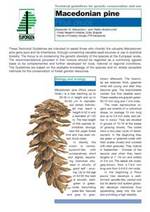Pinus peuce - Technical guidelines for genetic conservation and use for Macedonian pine
This species forms as pure, so mixed stands most often occur with Picea abies (L.) Karst., Pinus sylvestris L., Pinus mugo Turra and less often with Abies alba Mill., Pinus nigra Arn., Pinus heldreichii Christ., Fagus sylvatica L. and other species.
The contrasting bio-ecological peculiarities of Pinus peuce and Picea abies, of Pinus peuce and Abies alba and some other species have been combined very well in mixed, two-storeyed stands. That is why striving to establish such stands is reasonable from both the biological and ecological points of view.
The natural regeneration of Pinus peuce depends on a number of factors such as altitude, type of forest, rate and periodicity of seeding, crown closure, relief, application of corresponding felling, etc. The state of most of the Pinus peuce forests requires the processes of regeneration to be directed by foresters with a view to preserving, taking care of and propagating this species.
The in situ conservation method includes mainly the national and nature parks, reserves, seed stands and plus trees. By the ex situ method the genetic resources of Macedonian pine are preserved mainly through provenance testing plantations, progeny trial plantations, seed orchards and genebanks for seeds. Assessing the advantages of the two methods for conservation of genetic resources, in situ seems to be more reliable. The autochthonous populations of Pinus peuce in Pirin Mt., Pelister Mt. and Prokletije Mt. present valuable genetic resources for the introduction of this species in many countries of the Northern Hemisphere.
The area of Macedonian pine seed stands in Bulgaria is 693 ha and that of the seed orchards 10 ha, in Macedonia FYR - respectively 110 ha and 6 ha and in Serbia and Montenegro 10 ha of seed stands.
The high grade stands in which trees with spindle-shaped crowns and shallow-scaled bark fissuring prevail should be preferred for the purposes of breeding. The existence of two edaphotypes – silicate and carbonate – should be taken into consideration.
While selecting plus and candidate elite trees, individuals with narrow crown, fine and short branches of first order disposed approximately perpendicular to the stem should be selected.
Authors: Alexander H. Alexandrov; Vlatko Andonovski
Corporate Author: Bioversity International, Rome (Italy)
Journal/Series: EUFORGEN Technical Guidelines for Genetic Conservation and Use
Publication Year: 2011
Publication Format: PDF
ISBN 13: 978-92-9043-826-7
Language: EN
Pages: 6 p.

